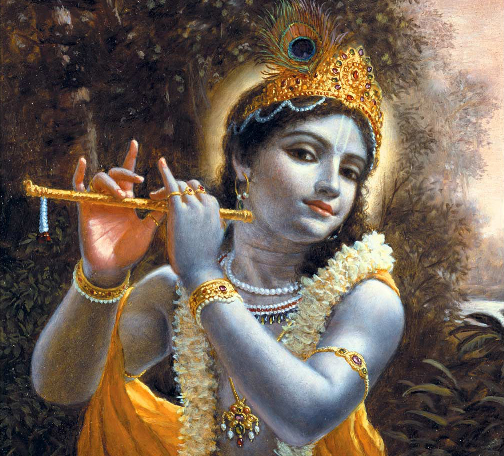Verse 3
chaturyaika–nidân–asima–chapala–apânga–chhatâ–
lâvanyamrita–katâksha-adritam,
kâlindi–pulina–ângana–pranayinam kâmâvatâr–bâlam
nilamani vayam madhurima–svarâjyam–âradhnumah.3.
Translation
He Whose extremely mischievous side-long glances dart like brilliant rays that slow down the graceful movements of the Vraja-beauties; Whose gaze is playing in the wavelets1 of nectarine lâvanya; Who is adored by the looks of Sri Râdhârâni; Whose most favourite sporting place is the bank of the Kâlindi, Who is the source of all the incarnations of the Love-god, Who is the empire of all sweetness – we worship That blue-complexioned Kishor.3.
|
H |
ereafter, Sri Lilâshuk received a sphurti of Sri Krishna accompanied by Sri Râdhârâni, the chief Gopi. They were surrounded by the sakhis who were serving Their Lordships. Earlier he had heard of Sri Râdhârâni’s anurâg and good fortune from Chintâmani. He now thinks of himself as Sri Râdhâ’s sakhi and is expressing his wish to another sakhi with a similar desire – “ami vayam bâlam aradhnumah”- “We shall worship the Kishor2 Krishna”, which means, that we shall serve Him by offering tâmbul3, by fanning Him etc. Here the word ‘bâl’ indicates Kishor. In the previous verse, the poet has described Krishna as ‘Kishor’. Later on also, throughout the text, he has described His pastimes only as a Kishor. Sri Krishna’s eternal form is that of a Kishor. The eternally Kishor Krishna sometimes expresses ‘bâlya4’ and at other times ‘pauganda5’ in order to relish the parental and friendly moods respectively.
“Krishna made his childhood fruitful by relishing parental love. He made His pauganda worthwhile by relishing the mood of friendship. He performed the Râs–dance with Râdhâ and the other Gopis. Thus, He relished the essence of ras to His heart’s content. In this manner He enriched His ‘kaishor’6.”
– (C.C. – Âdi.4.100-102)
From Smriti and Rhetoric also, we may conclude that Sri Krishna shows the ‘bâlya’ stage right up to 16 years since he has such a beautiful and tender body. Hence, in this verse as well, the word ‘bâlam’ refers to the Kishor Sri Krishna. If we translate ‘bâl’ as ‘bâlak’ (child), then the words ‘kâm–avatâr–ankuram7’ become inconsistent. In the same way, wherever Sripâd has used the words ‘bâl’, ‘shishu’ etc., they are supposed to mean ‘Kishor’ only.
What is this Kishor like? Well, He is ‘nilam’ – like beryl. He is blue– complexioned and the embodiment of the erotic ras. The colour of the erotic ras is ‘Shyâm8’ – Hence the word ‘nil’ has been used. Sri Bharat Muni has written in Nâtyashâstra –
“The erotic ras is blue in colour.”
Sri Krishna is Shringâr9 personified.
(A friend told Râdhârâni) –”Dear friend Râdhe! Sri Krishna, Who is charmed by the Gopis, is engrossed in performing sports as if He is the Shringâr-ras personified.” – (Geet–Govindam)
Sri Bhatta Goswâmipâd has explained ‘nilam’ –
“Sri Krishna’s bodily splendour is like the fully bloomed blue–lotus – hence He is the whole essence of Shringâr–ras.”
The gopis are saying – “Because of His beauty alone we have become His maid servants. He is as beautiful as He is ‘Surasik10’. That’s why He is always present on the floor of the Râs–dance on the banks of the Kâlindi. The banks of the Kâlindi are like a dance-floor, so they are very dear to him. He always performs pleasure–sports in the court yard surrounded by the Mâdhavi creepers that steal the heart of Mâdhav (Krishna); hence we call this pastime ‘Râs Lila’.”
The word Râs is derived from the root word ‘ras’. Hence, for Rasik–Shekhar Sri Krishna, Who is Shringâr personified, and is always eager to relish ras, the Râsa-sthali11 is His favourite haunt – therefore He always resides there. Sri Râdhâ adores this ‘Kishor – God’ (Sri Krishna) with Her sidelong glances – “laxmi – katâksha – âdritam”.
(to be continued)
1 small waves
2 adolescent
3 Betel leaves
4 childhood
5 age ranging from 5 years to 10 years
6 Noun-form of ‘kishor’
7 source of all the incarnations of the Love-god
8 dark blue
9 Eros
10 a good connoisseur of ras
11 the place where the Râs dance occurs

